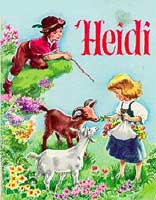
Dimdima
Online Children's Magazine from India

Dimdima
Online Children's Magazine from India
BOOK LIST
Author -

A book written a 120 years ago, about a little girl and her life high in the Swiss Alps still enchants readers.
Its writer, Johanna Spyri, was a little-known Swiss homemaker before she began writing Heidi. In her first Heidi book, written in 1880, "Heidi's Lehr und Wanderjahre" (Heidi's Formative Years) Johanna kept her identity secret with the anonymous inscription, "From the writer of A Leaf On Vrony's Grave". The book, however, was an immediate success.
In her next book, written in 1881, "Heidi kann brauchen, was es gelernt hat" (Heidi Might Need What She Has Learned), Joanna used her name on her stories.
Johanna Spyri lived in a small town, near Zürich, Switzerland. Her home was on the high Swiss Plateau, overlooking Lake Zürich. Beyond it lay alpine pastures and towering mountain peaks. The idyllic setting where Johanna spent the first 25 years of her life is reflected in most of her works.
In writing Heidi and other stories of life in the mountains of Switzerland, Johanna Spyri drew upon the memories of her own happy childhood. Although she wrote in German, Heidi has been translated into many languages and has been the subject of several motion pictures. In addition to Heidi--first published in two parts in 1880-81-Spyri's other books include The Little Alpine Musician, Uncle Titus, Gritli, and Veronica.
The main characters of the book are Heidi, a small orphan girl, who loves the high Swiss Alps; her grumpy, yet kindly grandfather; Peter, the goatherd; Peter's grandmother; Clara, a lonely little girl in Frankfurt; Mister Sesemann, Clara's father ; Heidi's Aunt Dete and Miss Rottenmeier, Clara's governess, who would like to dearly teach Heidi a few table manners.
The story begins with Heidi travelling up the Alps with her aunt, to live with her grandfather. Her grandfather lives in the Alps high above Maienfeld and the "Dörfli". Heidi had no suitcases and her clothes were not many. So her Aunt Deta made her wear all her clothes, and so looking very heavy and not at all happy, Heidi had made the trip up to the mountains.
She immediately takes to the life there. Every morning, she joins the goatherd Peter as he drives his herd up the alpine pastures to graze. In summer, the pastures are ablaze with flowers. In winter, the Alps change colour - a white carpet of snow covers the mountains. In spring, Aunt Deta returns to take Heidi with her to Frankfurt. Poor, lame Clara lives there in a wealthy home and Heidi has to keep her company. On her very first day in the big city, a tired Heidi falls asleep at the table, shocking everyone. However, Clara finds it funny. However, Heidi soon gets homesick and misses her grandfather.
Then strange things begin to happen in the house. Every morning the front door is found wide open, though it is closed and locked at night. There is one thought in everyone's minds, " Is there a ghost in the house?" One day, they keep watch and around midnight they hear a noise in the hall. Peering into the darkness, they discern a misty, white figure. "Who is there?" they shout. Slowly, the figure turns around - it is Heidi.
The doctor is called. He soon that Heidi is very homesick! "Only one remedy can help", he says. "Heidi has to go back to the Alps, back to everything she loves!" Soon, Heidi is on her way home, with a basket full of white rolls for Peter's grandmother. Everyone there is happy that Heidi is back.
Next year, Clara pays her a visit. This makes Peter jealous. One morning he kicks Clara's wheelchair down the mountainside. Grandfather has to carry Clara up to the Alps in his big strong arms, but she has other ideas. She tries to take a few steps on her own. It hurts at first. Then, all of a sudden she shouts: "I can do it, Heidi! Oh, I can walk!" It was indeed a miracle!
Peter admitted his bad deed and was indeed so sorry that his grandmother forgave him. Soon everything is fine again.
Last updated on :7/1/2003
EXPLORE MORE...
Dimdima is the Sanskrit word for âdrumbeatâ. In olden days, victory in battle was heralded by the beat of drums or any important news to be conveyed to the people used to be accompanied with drumbeats.
Bharatiya Vidya Bhavan
K. M Munshi Marg,
Chowpatty, Mumbai - 400 007
email : editor@dimdima.com
Bharatiya Vidya Bhavan
505, Sane Guruji Marg,
Tardeo, Mumbai - 400 034
email : promo@dimdima.com
Dimdima.com, the Children's Website of Bharatiya Vidya Bhavan launched in 2000 and came out with a Printed version of Dimdima Magazine in 2004. At present the Printed Version have more than 35,000 subscribers from India and Abroad.